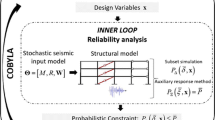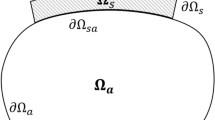Abstract
Non-linear fluid viscous dampers have found widespread applications in engineering practice for seismic mitigation of civil structures. Topology optimization has emerged as an appealing means to achieve the optimal design of non-linear viscous dampers in terms of both layouts and parameters. However, the conventional methodologies are mainly restricted to deterministic dynamic excitations. This research is devoted to the topology optimization of non-linear viscous dampers for energy-dissipating structures with consideration of non-stationary random seismic excitation. On the basis of the equivalent linearization—explicit time-domain method (EL-ETDM), which has been recently proposed for non-stationary stochastic response analysis of non-linear systems, an adjoint variable method-based (AVM-based) EL-ETDM is further proposed for non-stationary stochastic sensitivity analysis of energy-dissipating structures with non-linear viscous dampers. The stochastic response and sensitivity results obtained by EL-ETDM with high efficiency are utilized for topology optimization of non-linear viscous dampers with the gradient-based method of moving asymptotes. The optimization problem is formulated as the minimization of the maximum standard deviation of a critical response subjected to a specified maximum number of viscous dampers, and the p-norm function is employed for approximation of the non-smooth objective function. The existence information of each potential viscous damper as well as the damper parameters are characterized by continuous design variables, and the solid isotropic material with penalization technique is utilized to achieve clear existences of viscous dampers. Two numerical examples are presented to illustrate the feasibility of the proposed topology optimization framework.




























Similar content being viewed by others
References
Altieri D, Tubaldi E, De Angelis M, Patelli E, Dall’Asta A (2018) Reliability-based optimal design of nonlinear viscous dampers for the seismic protection of structural systems. Bull Earthq Eng 2:1–20
Aydin E (2012) Optimal damper placement based on base moment in steel building frames. J Constr Steel Res 79:216–225
Aydin E, Boduroglu MH, Guney D (2007) Optimal damper distribution for seismic rehabilitation of planar building structures. Eng Struct 29(2):176–185
Bae KR, Wang S. Reliability-based topology optimization. 9th AIAA/ISSMO Symposium on Multidisciplinary Analysis and Optimization. American Institute of Aeronautics and Astronautics, Atlanta, Georgia, USA, Sep. 4–6, 2002
Basili M, De Angelis M (2007) Optimal passive control of adjacent structures interconnected with nonlinear hysteretic devices. J Sound Vib 301:106–125
Batir N (2007) On some properties of digamma and polygamma functions. J Math Anal Appl 328:452–465
Bendsoe MP (1989) Optimal shape design as a material distribution problem. Struct Optim 1(4):193–202
Ben-Tal A, Bendsoe MP (1993) A new method for optimal truss topology design. SIAM J Optim 3(2):322–358
Chen JB, Yang JS, Jensen H (2020) Structural optimization considering dynamic reliability constraints via probability density evolution method and change of probability measure. Struct Multidisc Optim 62:2499–2516
Chun JH, Song JH, Paulino GH (2016) Structural topology optimization under constraints on instantaneous failure probability. Struct Multidisc Optim 53(4):773–799
Di Paola M, Navarra G (2009) Stochastic seismic analysis of MDOF structures with nonlinear viscous dampers. Struct Control Health Monit 16(3):303–318
Gao XJ, Li YX, Ma HT, Chen GF (2020) Improving the overall performance of continuum structures: a topology optimization model considering stiffness, strength and stability. Comput Methods Appl Mech Eng 359:112660
Gidaris I, Taflanidis AA (2015) Performance assessment and optimization of fluid viscous dampers through life-cycle cost criteria and comparison to alternative design approaches. Bull Earthq Eng 13(4):1003–1028
Gomez F, Spencer BF (2019) Topology optimization framework for structures subjected to stationary stochastic dynamic loads. Struct Multidisc Optim 59:813–833
He F, Liao HQ, Zhu JH, Guo ZZ (2019) Structural topology optimization under stationary random base acceleration excitations. Chin J Aeronaut 32(6):1416–1427
Housner GW, Bergman LA, Caughey TK, Chassiakos AG, Claus RO, Masri SF, Skelton RE, Soong TT, Spencer BF, Yao JT (1997) Structural control: past, present, and future. ASCE J Eng Mech 123(9):897–971
Hu ZQ, Su C, Chen TC, Ma HT (2016) An explicit time-domain approach for sensitivity analysis of non-stationary random vibration problems. J Sound Vib 382:122–139
Hu ZQ, Wang ZQ, Su C, Ma HT (2018) Reliability based structural topology optimization considering non-stationary stochastic excitations. KSCE J Civ Eng 22(3):993–1001
Jang HL, Cho S (2017) Adjoint design sensitivity analysis of constant temperature molecular dynamics. Int J Mech Mater Des 13:243–252
Jensen HA, Sepulveda JG (2012) On the reliability-based design of structures including passive energy dissipation systems. Struct Saf 34(1):390–400
Jung HS, Cho S (2004) Reliability-based topology optimization of geometrically nonlinear structures with loading and material uncertainties. Finite Elem Anal Des 41(3):311–331
Kanai K (1957) Semi empirical formula for the seismic characteristics of the ground. Bull Earthq Res Inst 35(2):309–325
Kharmanda G, Olhoff N, Mohamed A, Lemaire M (2004) Reliability-based topology optimization. Struct Multidisc Optim 26(5):295–307
Lang ZQ, Guo PF, Takewaki I (2013) Output frequency response function based design of additional nonlinear viscous dampers for vibration control of multi-degree-of-freedom systems. J Sound Vib 332(19):4461–4481
Lavan O, Amir O (2014) Simultaneous topology and sizing optimization of viscous dampers in seismic retrofitting of 3D irregular frame structures. Earthq Eng Struct Dyn 43(9):1325–1342
Le C, Norato J, Bruns T, Ha C, Tortorelli D (2010) Stress-based topology optimization for continua. Struct Multidisc Optim 41:605–620
Lee CL, Chen YC, Chung LL, Wang YP (2006) Optimal design theories and applications of tuned mass damper. Eng Struct 28:43–53
Lin WH, Chopra AK (2002) Earthquake response of elastic SDF systems with non-linear fluid viscous dampers. Earthq Eng Struct Dyn 31(9):1623–1642
Liu K, Paulino GH, Gardoni P (2016) Reliability-based topology optimization using a new method for sensitivity approximation-application to ground structures. Struct Multidisc Optim 54(3):553–571
Lopez Garcia D, Soong TT (2002) Efficiency of a simple approach to damper allocation in MDOF structures. J Struct Control 9(1):19–30
Martínez CA, Curadelli O, Compagnoni ME (2014) Optimal placement of nonlinear hysteretic dampers on planar structures under seismic excitation. Eng Struct 65:89–98
Min SJ, Ban SH (2005) Structural topology design considering reliability. Key Eng Mater 297:1901–1906
Newmark NW (1959) A method of computation for structural dynamics. J Eng Mech Div 85(7):67–94
Ok SY, Song JH, Park KS (2008) Optimal design of hysteretic dampers connecting adjacent structures using multi-objective genetic algorithm and stochastic linearization method. Eng Struct 30:1240–1249
Pollini N, Lavan O, Amir O (2017) Minimum-cost optimization of nonlinear fluid viscous dampers and their supporting members for seismic retrofitting. Earthq Eng Struct Dyn 46(2):1941–1961
Rong JH, Tang ZL, **e YM, Li FY (2013) Topological optimization design of structures under random excitations using SQP method. Eng Struct 56(6):2098–2106
Soong TT, Spencer BF (2002) Supplemental energy dissipation: state-of-the-art and state-of-the-practice. Eng Struct 24(3):243–259
Stolpe M, Svanberg K (2001) An alternative interpolation scheme for minimum compliance topology optimization. Struct Multidisc Optim 22:116–124
Su C, Xu R (2014) Random vibration analysis of structures by a time-domain explicit formulation method. Struct Eng Mech 52(2):239–260
Su C, Huang H, Ma HT (2016) Fast equivalent linearization method for nonlinear structures under non-stationary random excitations. ASCE J Eng Mech 142(8):04016049
Su C, Li BM, Chen TC, Dai XH (2018) Stochastic optimal design of nonlinear viscous dampers for large-scale structures subjected to non-stationary seismic excitations based on dimension-reduced explicit method. Eng Struct 175:217–230
Su C, **an JH, Huan H (2021) An iterative equivalent linearization approach for stochastic sensitivity analysis of hysteretic systems under seismic excitations based on explicit time-domain method. Comput Struct 242:106396
Sun GJ, Li HJ (2004) Stationary models of random earthquake ground motion and their statistical properties. Earthq Eng Eng Vib 24(6):21–26
Svanberg K (1987) The method of moving asymptotes—a new method for structural optimization. Int J Numer Meth Eng 24(2):359–373
Svanberg K (1995) A globally convergent version of MMA without line search. First World Congress of Structural and Multidisciplinary Optimization. Pergamon Press, Goslar, pp 9–16
Symans MD, Charney FA, Whittaker AS, Constantinou MC, Kircher CA, Johnson MW, McNamara RJ (2008) Energy dissipation systems for seismic applications: current practice and recent developments. ASCE J Struct Eng 134(1):3–21
Takewaki I (2000) Optimal damper placement for planar building frames using transfer functions. Struct Multidisc Optim 20(4):280–287
**an JH, Su C, Spencer BF (2020a) Stochastic sensitivity analysis of energy-dissipating structures with nonlinear viscous dampers by efficient equivalent linearization technique based on explicit time-domain method. Probab Eng Mech 61:103080
**an JH, Su C, Guo HZ (2020b) Seismic reliability analysis of energy-dissipation structures by combining probability density evolution method and explicit time-domain method. Struct Saf 88:102010
Xu JQ, Fermandois GA, Spencer BF, Lu XL (2018) Stochastic optimisation of buckling restrained braced frames under seismic loading. Struct Infrastruct Eng 14(10):1386–1401
Yang Y, Zhu M, Shields MD, Guest JK (2017) Topology optimization of continuum structures subjected to filtered white noise stochastic excitations. Comput Methods Appl Mech Eng 324:438–456
Zhang Q, Zhang WH, Zhu JH, Gao T (2012) Layout optimization of multi-component structures under static loads and random excitations. Eng Struct 43(43):120–128
Zhang WH, Liu H, Gao T (2015) Topology optimization of large-scale structures subjected to stationary random excitation: an efficient optimization procedure integrating pseudo excitation method and mode acceleration method. Comput Struct 158:61–70
Zhao XQ, Wu BS, Lai SK, Li ZG, Zhong HX (2021) A PEM-based topology optimization for structures subjected to stationary random excitations. Eng Struct 229:111613
Zhu HP, Ge DD, Huang X (2011) Optimum connecting dampers to reduce the seismic responses of parallel structures. J Sound Vib 330:1931–1949
Zhu M, Yang Y, Guest JK, Shields MD (2017) Topology optimization for linear stationary stochastic dynamics: applications to frame structures. Struct Saf 67:116–131
Acknowledgements
The research is funded by the National Natural Science Foundation of China (51678252, 52178479) and the Guangdong Provincial Key Laboratory of Modern Civil Engineering Technology (2021B1212040003).
Author information
Authors and Affiliations
Corresponding author
Ethics declarations
Conflict of interest
On behalf of all authors, the corresponding author states that there is no conflict of interest.
Replication of results
The MATLAB code involved in the present study can be made available to interested parties upon request to the authors.
Additional information
Responsible Editor: Seonho Cho
Publisher's Note
Springer Nature remains neutral with regard to jurisdictional claims in published maps and institutional affiliations.
Appendix A
Appendix A
Differentiating Eq. (11) with respect to \(\theta\), one has
where the sensitivity of the equivalent dam** parameter with respect to \(\theta\), \({{\partial c_{k} (\tau )} \mathord{\left/ {\vphantom {{\partial c_{k} (\tau )} {\partial \theta }}} \right. \kern-\nulldelimiterspace} {\partial \theta }}\), can be derived from Eq. (8) as follows:
in which \(\psi ( \bullet )\) is the digamma function or psi function defined as \(\psi ( \bullet ) = {{\Gamma^{\prime}( \bullet )} \mathord{\left/ {\vphantom {{\Gamma^{\prime}( \bullet )} {\Gamma ( \bullet )}}} \right. \kern-\nulldelimiterspace} {\Gamma ( \bullet )}}\) (Batir 2007).
Rights and permissions
About this article
Cite this article
Su, C., **an, J. Topology optimization of non-linear viscous dampers for energy-dissipating structures subjected to non-stationary random seismic excitation. Struct Multidisc Optim 65, 200 (2022). https://doi.org/10.1007/s00158-022-03281-2
Received:
Revised:
Accepted:
Published:
DOI: https://doi.org/10.1007/s00158-022-03281-2




